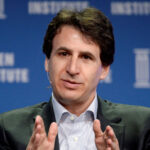
Hello! I’m traveling back from the Bright Start International Conference where I spent the last few days learning about early childhood policies, systems and best practices worldwide. This week’s newsletter comes to you from Caroline Preston, Hechinger’s managing editor, who writes our climate and education newsletter. You can sign up for the newsletter here. I’ll see you in two weeks!
Best,
Jackie
“What does ‘endangered’ mean?” Vicki Sando asked a class of first graders on a recent Monday at P.S. 41 Greenwich Village School in Manhattan.
It was the first day of a three-day lesson in which the students would design and build their own contraptions to protect turtle eggs from danger. After watching a video on threats facing sea turtles, including rising sea levels and warming temperatures due to climate change, the students scattered to different tables. There, with a $1 total for supplies, they plotted out how they’d use cardboard, cotton balls and other materials to build their turtle egg containers.
The project is solutions-oriented and hands-on, requiring students to collaborate, think creatively, and use math to solve a problem. Sando, a STEM teacher, said she often takes a solutions approach when introducing her elementary students to climate change; another lesson for kindergartners involves designing a barrier to protect a playground from flooding. “I think they need to know about it at a young age, ignoring it won’t serve anybody, but it’s making them problem solvers,” she told me.
Even a decade ago, the topic of climate change was, to many, academic and remote. But as temperatures rise, wildfires spread and storms intensify, the consequences of climate change have become part of life. It’s difficult for even the youngest children to overlook: Recently my 3.5-year-old noticed the smoky air caused by a fire in a nearby park and asked: “Why is the sky fuzzy?”

All of that has made it increasingly important for teachers to introduce the topic in the earliest grades, beginning in preschool, according to Kottie Christie-Blick, a climate change education consultant and an instructor at the University of San Diego. Christie-Blick was among several experts I spoke with about best practices for talking with the youngest students about climate change.
In the earliest grades, lessons should focus on cultivating an appreciation for and understanding of the natural world, said Emily Townsend, K-5 education specialist at SubjectToClimate, which provides resources for educators on climate instruction. Students can learn about how plants, animals, humans and the planet are interconnected, and how changes to the planet affect those living beings.
Focusing on how a warming planet affects animals is less immediate and easier to grasp than talking about how it affects humans, said Christie-Blick. Lessons can directly connect to students’ communities, said Kimi Waite, a former kindergarten teacher and an assistant professor of child and family studies at California State University, Los Angeles. Students might use Google maps to study tree coverage and heat islands in their communities, she said.
While harms from climate change are upsetting, it’s unlikely that young kids will get emotional about these lessons, said Christie-Blick. They tend to think in matter-of-fact ways and believe they can fix anything, she noted. But she and others said it’s important to build in classroom practices like morning circles to help students talk through any emotions they may feel, especially those stemming from disasters they’ve experienced directly. If students do seem upset, give them space to take a break from a discussion, advised Townsend.
Lessons can also be fun: Learning about flooding, for example, might involve water play, said Christie-Blick.
One of the biggest obstacles to climate instruction is educator discomfort: Surveys suggest that teachers across all grades are reluctant to instruct about climate change because they don’t feel confident in their own knowledge. But Waite noted that educators can incorporate the topic into activities they already do, like art lessons or reading picture books. (I once attended an elementary school lesson in which the teacher read a book about a family beach house after Hurricane Sandy.) If students challenge the idea of climate change, for example, by noting that a parent doesn’t “believe” in it, Townsend advises teachers to keep the focus on what’s happening around us, rather than engaging in a less concrete discussion.
During Sando’s sea turtle lesson at PS 41, the kids were busy cutting cardboard and taping bubble wrap inside yogurt containers to protect their eggs from a fall (the lesson is a twist on the classic egg drop challenge). Split into teams with names such as “Protect the Egg,” “Rock and Roll Turtle” and “Team Turtle,” the students screeched when they were reminded by the group’s designated “timekeeper” that they were starting to run out of time.
In the video they’d watched, the students had learned that warmer temperatures caused more female eggs to hatch than male eggs, leading to a shortage of males. (“What does female mean?” one student asked; another said, “Is it like that for people?”)
When I spoke to some of the students about what they remembered from the lesson, the kids for the most part didn’t mention climate change. But one kid, Abe, talked to me about how the turtles were in trouble and that climate change was causing more girl turtle eggs, meaning there weren’t enough males. He said he’d heard about climate change “a lot of times,” mostly from his parents but also in class. “It’s making things too hot,” he said. — Caroline Preston
Here are a few resources on how to teach the youngest students about climate change:
Climate lessons for teachers, by Kottie Christie-Blick
Lesson plans for elementary students, by SubjectToClimate and Sustainable Jersey for Schools
“What teachers want to know about teaching climate change,” forthcoming book by Kimi Waite, Bertha Vazquez and Lauren Madden
Climate anxiety: SEL resources for teachers, by Emily Townsend
SkepticalScience, a site for rebutting climate misinformation
Ecofiction for children, compiled by Kottie Christie-Blick
Research Quick Take
Only about a quarter of 3- and 4-year-olds in low- and middle-income countries receive “adequate nurturing care,” as measured by time spent with caregivers doing activities including reading and play. That’s one of the findings of a new pair of reports published by The Lancet. The studies also found less than 40 percent of young children in these countries — which include dozens across Central and South America, Africa and Asia — have access to early childhood care and education services.
More Early Childhood news
“Surging insurance costs are threatening the future of child care,” The Hechinger Report
“Massachusetts child care has a workforce problem,” Axios Boston
“New report finds state pilot program increased child care availability, staffing,” Iowa Capital Dispatch
“Map shows most expensive states for child care,” Newsweek
“Texas businesses call on lawmakers to reform child care during 89th legislative session” San Antonio Report
This story about climate change for kids was produced by The Hechinger Report, a nonprofit, independent news organization focused on inequality and innovation in education. Sign up for the Hechinger newsletter.
The post ‘Why is the sky fuzzy?’: Climate change lessons need to start as early as preschool appeared first on The Hechinger Report.
Hello! I’m traveling back from the Bright Start International Conference where I spent the last few days learning about early childhood policies, systems and best practices worldwide. This week’s newsletter comes to you from Caroline Preston, Hechinger’s managing editor, who writes our climate and education newsletter. You can sign up for the newsletter here. I’ll
The post ‘Why is the sky fuzzy?’: Climate change lessons need to start as early as preschool appeared first on The Hechinger Report. Early Education, Solutions, climate change, Curriculum, Newsletter, STEM, teachers The Hechinger Report






